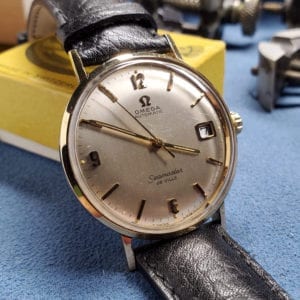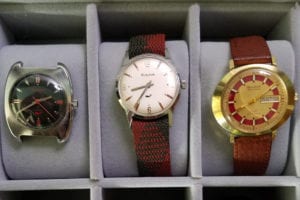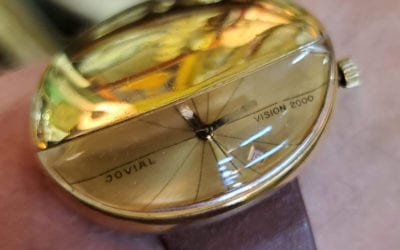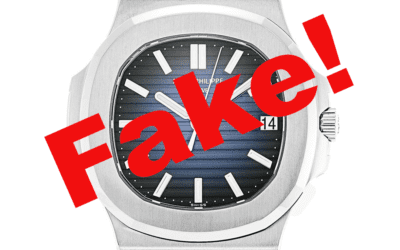I began collecting watches and learning to do some of my own maintenance just a couple years ago for a several reasons. First, I encountered an old Hamilton in a second-hand store that reminded me of a watch I had seen at my grandfather’s house when I was a kid. Beyond the nostalgia, I wanted a hobby that would satisfy my urge to tinker with mechanical things while not taking up as much space as woodworking had in the past. With watches, your entire collection can live in a box the size of a briefcase. And you can carry a piece of your collection every day if you want—it’s a hobby not relegated to weekends in the basement.
You undoubtedly have your own reasons, otherwise you never would have found this page. But you also probably have some questions. I can’t claim to know everything about starting a watch collection, but I have learned a few tips and tricks that I’m happy to pass along. I hope you find them useful.
Find a Theme
As I’m writing this, eBay lists more than 2.1 million new and used mechanical, electronic, and other watches for sale.
There have been literally billions of wristwatches produced over the last century-plus. In 2015 alone, the Contrôle Officiel Suisse des Chronomètres (COSC), which certifies the precision of Swiss watches, approved more than 1.5 million watches. And only about 6 percent of all watches exported from Switzerland go through COSC. Add all the watches being produced in Japan and China not to mention elsewhere in the world, and you get the picture. It’s a lot of watches. And those are just the new ones.
 When I first started, I didn’t really know where to begin. So I started with my birth year. That led me down a rabbit hole of good watches from the late 1960s, that eventually found me buying a 1967 Omega SeaMaster De Ville from Quarter Past Time while on vacation in New Orleans. (I’ve since been convinced that buying a birth-year watch is not a good basis for a collection, but it did get me started.)
When I first started, I didn’t really know where to begin. So I started with my birth year. That led me down a rabbit hole of good watches from the late 1960s, that eventually found me buying a 1967 Omega SeaMaster De Ville from Quarter Past Time while on vacation in New Orleans. (I’ve since been convinced that buying a birth-year watch is not a good basis for a collection, but it did get me started.)
That watch, however, was pretty pricey, and I couldn’t see myself building a collection of watches of that caliber. That realization started me looking at more affordable brands and models, including Bulova, Gruen, Benrus, some Hamiltons, Elgin, and more. A Bulova Sea King, with its little whale logo, caught my eye, and soon I’d caught five different variations. Then I discovered pointer date watches, which landed a couple of them in my collection. Gruen art deco models were next. Then vintage Roamers.
I enjoyed the sense of exploration and finding out new things, and much of what I learned about one brand or model had at least some carry over to others. But I soon found myself spread too thin. I couldn’t know enough about any one thing to make proper buying decisions or even to keep my eBay saved searches to a manageable number.
 It took a while, but I started to focus. I learned that Gruen watches with the 870 movement had a bad reputation even when they were new. I discovered that vintage Roamers in good shape often come from Europe, so shipping charges made it hard to buy them affordably. I found that Bulova made multiple models with the whale logo—and that a lot of them are really pretty plain.
It took a while, but I started to focus. I learned that Gruen watches with the 870 movement had a bad reputation even when they were new. I discovered that vintage Roamers in good shape often come from Europe, so shipping charges made it hard to buy them affordably. I found that Bulova made multiple models with the whale logo—and that a lot of them are really pretty plain.
Now I tend to concentrate on Bulovas a bit more broadly, including interesting variations on their whale-logo waterproof models as well as earlier Art Deco pieces. I like the fact that parts are readily available and that the movements are generally simple enough that I can work on them even with my limited skills and experience. I’m sure my tastes will change, but by focusing, I’m actually getting more enjoyment and less frustration out of the hobby.
Join a Group
This is the organization to which you need to belong. Basic membership is less than $100 a year and includes six issues of Watch & Clock Bulletin, access to regional and national meetings, and the chance to borrow (via mail or in person) from the association’s vast library of watch resources, including books, videos, vintage technical bulletins, materials catalogs and more.
Horological Society of New York
“America’s First Watchmaking Guild, Founded 1866” provides a wealth of information both free to to public and for members ($100/year). The Society regularly hosts fascinating lectures on all aspects of horology (including this excellent tutorial on vintage watch collecting) and makes videos of them free to the public. Members get earlier access to the videos, can attend the lectures in person, and can take advantage of the society’s library.
The most-visited (they claim) watch site in the world. The main public forum has more than 2.2 million posts, so I have a hard time doubting them. Dig through old threads, ask questions, buy and sell. It’s a bit daunting at first, but once you settle in, you’ll find endless information.
One of the long-time forum sites for watch enthusiasts, but catering more to the high-end. (Thus I don’t visit it much myself.)
Not as active as some others since it’s only NAWCC members, but I’ve found excellent repair information here, and the forums are frequented by some of the most historically knowledgeable collectors you’ll find.
Just Horology is exactly what it says it is: a group dedicated to people interested in watches and clocks. New to old. Expensive to cheap. It’s all here and (relatively) judgement-free.
Facebook – Retro & Vintage Watches & Restorations
“No watch snobbery allowed” is one of the best parts of this group intended for people who like old watches as well as amateur watchmakers trying to repair them.
Facebook – Art Deco and Vintage American Wristwatches
Hamilton, Bulova, Illinois, Elgin, Waltham and more classic American watches. You’ll find a lot of gorgeous examples here if you’re trying to get ideas for your own collection.
Search Everywhere
One of the joys of watch collecting is finding unexpected treasures. No matter where I go now, I’m always on the lookout for opportunities to find watches. I have yet to discover a Patek Philippe in a Goodwill or an IWC at a yard sale, but I live in hope. I even posted a note on our local Nextdoor site and had a couple people give me older watches that weren’t working so I could practice. There are also local chapters of the NAWCC in many locations that have regular get-togethers where you can interact with other enthusiasts and maybe find that special watch you’ve been wanting.
Enjoy eBay–but Be Careful
I’ve bought multiple “not running but good balance” watches for parts off eBay. Often the seller will make a note like “probably just needs a good cleaning” or some other implication that only a minor bit of work will turn the watch into a runner. Maybe I’m just unlucky, but of all the watches with “good balances” I’ve purchased, not one didn’t have some significant problem that needed addressing. Those problems have ranged from missing roller jewels to wheels with broken pivots to mangled setting mechanisms—impossible to fix? No. Solved with a quick dip in the ultrasonic cleaner and a few drops of oil? No way.
Also, be wary of “recently serviced” watches. While some reputable vendors on eBay clearly have a real pro do a proper job on their watches, there are countless horror stories on the forums of watches that clearly had been mangled by poorly trained amateurs in a rush. I had read what I assumed were joking “eBay watches dipped in WD-40 and called serviced” posts online, too, and laughed—up until I received an old, unworking triple-date watch that was almost literally swimming in oil. Someone at some point apparently tried to dip the whole movement in an attempt to get it running rather that doing a proper job—not realizing that doing so gets oil on things that shouldn’t have it (such as hairsprings, calendar disks, and, eventually, dials).
If the seller doesn’t show the movement of the watch—even if the watch is advertised as running—also be careful. I’m not saying absolutely don’t buy the watch, but I cut my maximum bid for such mysteries by 25 percent or so to reduce my risk, just in case it arrives, I open it, and I discover that the movement inside isn’t the right one for the model or has been mangled in some way, even if it still runs.
Then again, sometimes you just get lucky on eBay. It can happen.
Understand the Difference Among Fakes, Frankens, Redials Replicas, “Homages,” and “Marriage” Watches
Given their potentially high value, easy portability, and the tendency for many buyers to not be experts, fake watches have long been a problem. Worse, modern manufacturing techniques have made it possible for more fakes to hit the market, and some of them are so good that even trained pros can have trouble telling them from the real thing.
Then there are replicas. These are watches—often made by the original brand—that mimic an earlier classic design. (A good example is the Hamilton Piping Rock, which has been released multiple times by Hamilton since the 1920s, most recently in the 1990s as a quartz model.)
Homages are watches that don’t claim to be the original but that borrow—some would say steal—design elements intended to make the watch look a lot like a well-known model. Some of these homage watches are close enough to the original in look that from a typical watch-on-the-wrist distance, most people wouldn’t be able to tell the difference. The main distinction, of course, is that the homages cost a fraction of the real thing and usually aren’t made nearly as well.
Frankenwatches are another issue, and how big a problem they are depends on whom you ask. A frankenwatch is a watch that is made up of parts from multiple other watches. Definitions differ, but I think of frankens as taking parts from one brand and model (such as a movement) and putting them into another completely different brand and model, sometimes just to get the watch running, but sometimes to intentionally deceive a buying into thinking they’re getting something they aren’t.
Marriage watches typically take parts from one model and brand, and move them into another watch by the same brand, but in a way that never would have been done by the manufacturer. (Say, taking a late 1960s dial and putting it into an early 1960s case, or swapping a late generation movement into an early generation watch.)
Frankens are despised by watch collectors in general—almost as much as outright fakes. Marriage watches, depending on the egregiousness of the merger, seem to be less of a problem, though they still aren’t worth nearly as much as an original.
Then there are redials—another source of debate in the watch collecting world. Much of the value of any watch is in the condition of the dial. Dials are fragile and easily damaged by moisture, sunlight, and servicing accidents. So a classic watch with a pristine dial will be worth far more than a similar model with a damaged dial. (There are a few exceptions, such as certain watches with “tropical” patina on the dial.) Given their tendency to show their age, many watches have been “redialed” by having the original re-painted. In best cases, these redials are done by highly skilled companies—even the original manufacturer—that use the original dial printing dies to essentially duplicate the look of the watch when it first left the factory. Worst case is when someone redials a watch poorly—doing work by hand, for instance, that would have been done by a machine, introducing typographical errors or other mistakes, or using colors or styles that never would have appeared on the original. (Some eBay sellers are notorious for selling watches with dials in a kaleidoscope of colors that never existed on the originals from the factory.)
No matter the quality of the redial, collectors devalue such watches compared with an original dial in fantastic condition. Where the debate lies in at what point a dial is so poor that a redial would actually increase the watch’s value. Some collectors argue you should almost never redial a watch. Others say that a good redial is better than a dial so ugly you wouldn’t want to wear the watch anyway.
One sign of a reputable eBay watch dealer is one who makes it clear when they think—or know—that a watch has been redialed and say so up front. Some of these dealers actually sell redialed watches for far more than less-clean original models because of their commitment to trying to be as close to the original as possible.
How can you identify a redial? It’s not always easy, but be wary of watches where the dial is in vastly better shape than the rest of the watch. Compare the dial on the watch you want to pictures of similar models elsewhere. Look for typos or inconsistency in how numbers or letters are printed. Hodinkee has a great guide with pictures to help you develop your own skill at identifying redials.
Learn to Maintain Your Watches Yourself
Nothing increased my appreciation for the watchmaker’s art more than the first time I disassembled a movement and tried to put it back together in working condition. These tiny machines truly are mechanical marvels that only fully expose their beauty under a loupe.
I, like many people I suspect, considered that my age, fading eyesight, and far from surgeon-still hands were insurmountable roadblocks to working on watches, but I found that isn’t true. Magnifying lenses can resolve many vision issues—some watchmakers even use stereo inspection microscopes and projection screens. And a properly set up workbench provides stability for shaky hands.
Also, if like me you’re collecting watches that cost in the hundreds, not thousands of dollars, paying to have them serviced makes little economic sense. A full service on any watch can cost $150 to $450 or more, depending on where you live, who you hire, and the complexity of the model. Most of the watches I buy cost less than $200, so paying that or more for a service every three to five years doesn’t make much financial sense. By learning to work on the watches myself, I’ve developed a better understanding of my hobby and also saved myself some money. (I still don’t dare touch my more complicated and expensive watches yet, though.)
No BS Watchmaking Course
Anthony L is a watchmaker specializing in high-end brands and also the author of the No BS Watchmaker book, which I highly recommend. His online watch repair course is still in beta testing (I’m one of the testers) but has already helped me greatly enhance my abilities. You can pre-register now.
Watch Repair Channel
Mark Lovic is a longtime watchmaker who has spent years posting free videos of his work on YouTube. He also has a more structured, three-part online course at Watch Repair Lessons. I haven’t taken his course, but his free videos have been invaluable in helping me identify issues in my own watches and learn various techniques.
Other options with which I have no personal experience:
The NAWCC also has a page listing a wide variety of learning resources, both online and in-person: Learning to Repair Clocks and Watches
Recent Posts
Check below for my latest posts on collecting vintage watches that won’t break your budget.
Space-age Flea Market Watch Find – The 1970 Jovial Vision 2000
Note: This watch is currently up for auction on eBay until April 11, 2023. On a recent trip to Montreal I visited the Market St-Michel Flea market and discovered a vendor who had a nice collection of watches ranging from a 1920s Waltham to 1980s LCD models. As I...
Frankens, Fakes, and Other Horological Monsters for Watch Collectors
Given their potentially high value, easy portability, and often inexperienced buyers eager for a bargain, fake watches are a goldmine for shady people out to make a dishonest buck. In the past, many of these fakes were obvious, poor copies that gave up their true...
eBay Search Tips for Vintage Watch Collectors (and Everyone Else)
I've been an eBay member since 1998. And while the auction juggernaut certainly has plenty of problems, I've found it an invaluable resource both for buying and selling all kinds of collectibles. But if you're just using the site's standard search to find what you...




Recent Comments